Economics Assignment: Macroeconomic and Monetary Development of Canada
VerifiedAdded on 2023/06/11
|14
|2685
|442
AI Summary
This economics assignment discusses recent macroeconomic and monetary development of Canada. It covers real GDP growth rate, inflation rate, unemployment rate, total debt, interest and exchange rate. It also discusses the monetary policy of Canada and regression analysis of real money demand function. The paper concludes with recommendations for Bank of Canada to control inflation and maintain a stable economy.
Contribute Materials
Your contribution can guide someone’s learning journey. Share your
documents today.
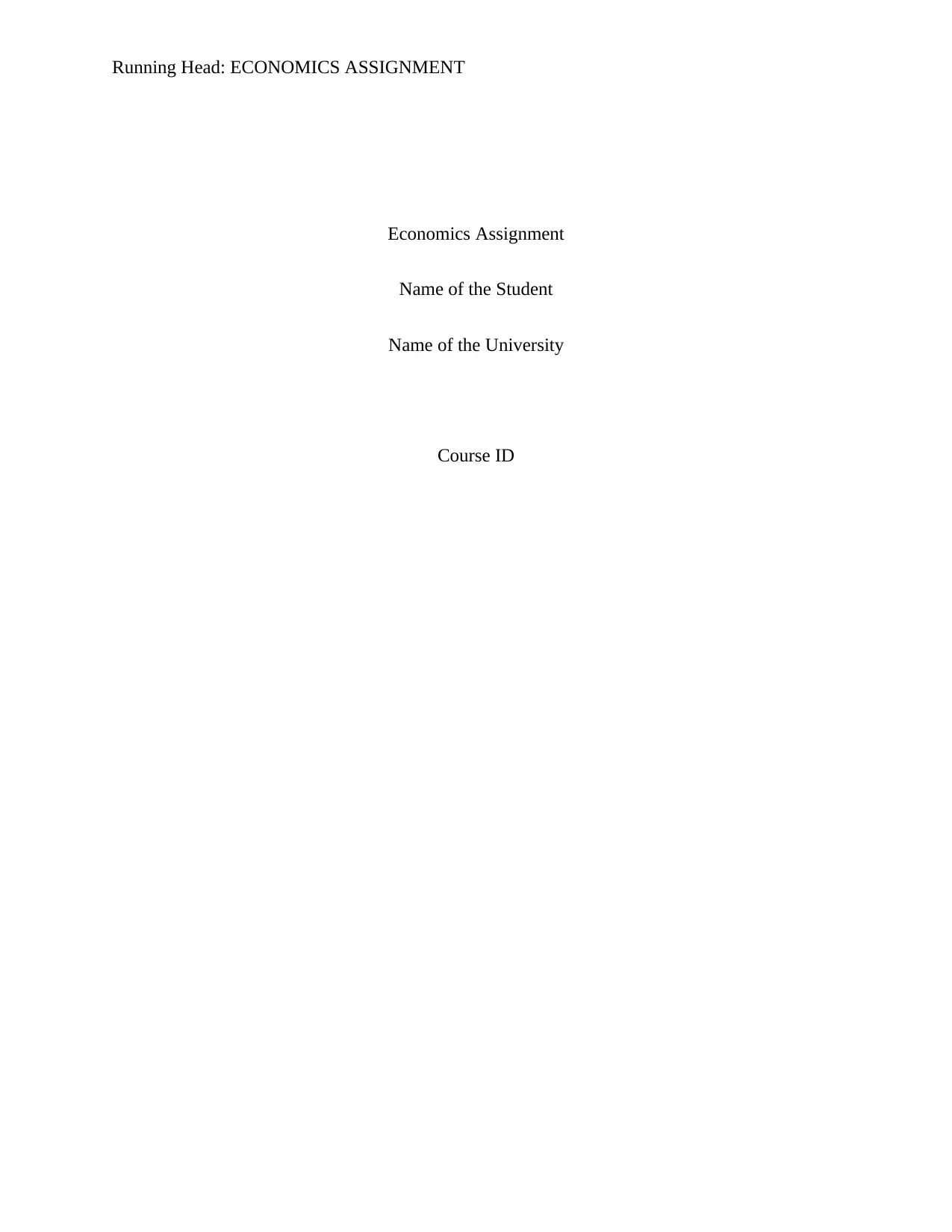
Running Head: ECONOMICS ASSIGNMENT
Economics Assignment
Name of the Student
Name of the University
Course ID
Economics Assignment
Name of the Student
Name of the University
Course ID
Secure Best Marks with AI Grader
Need help grading? Try our AI Grader for instant feedback on your assignments.
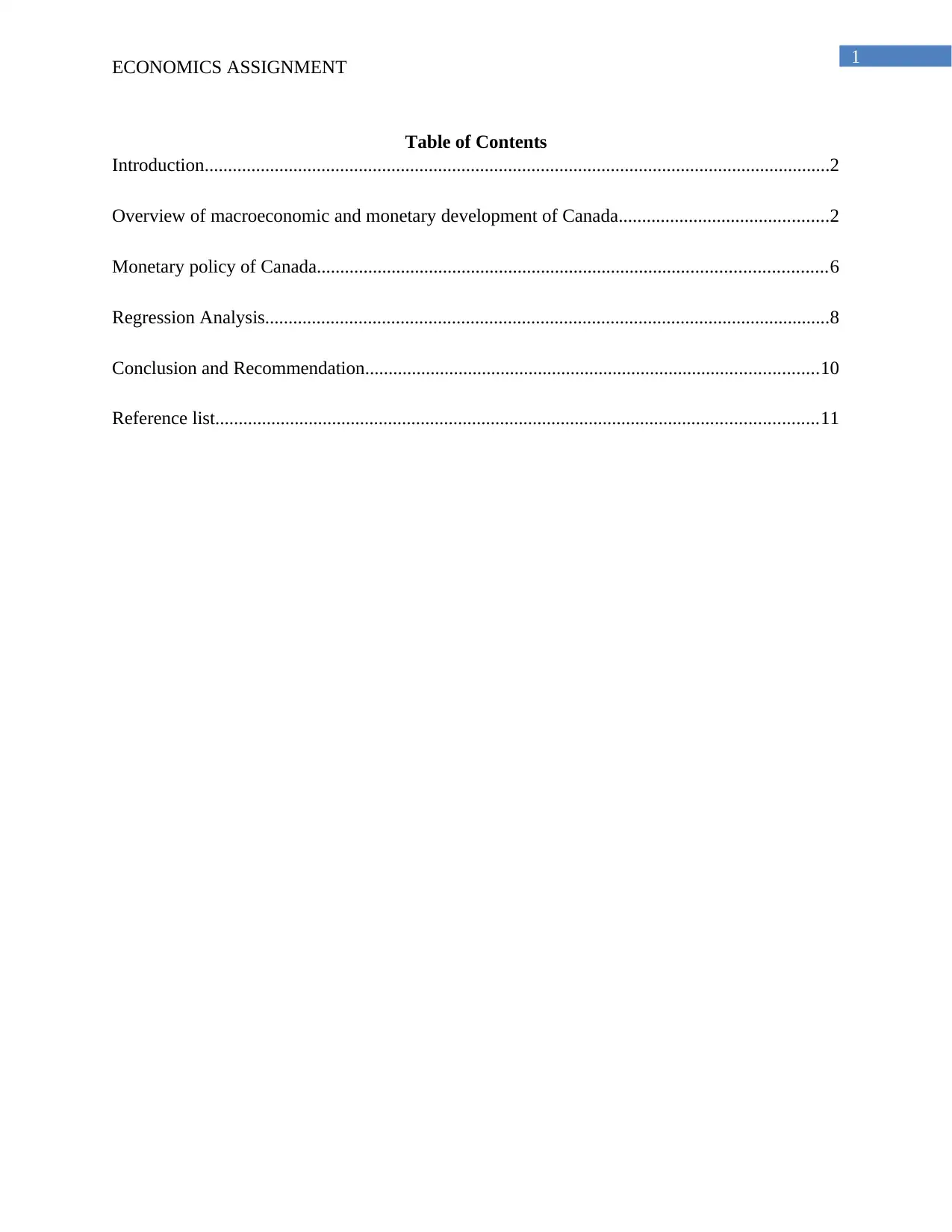
1
ECONOMICS ASSIGNMENT
Table of Contents
Introduction......................................................................................................................................2
Overview of macroeconomic and monetary development of Canada.............................................2
Monetary policy of Canada.............................................................................................................6
Regression Analysis.........................................................................................................................8
Conclusion and Recommendation.................................................................................................10
Reference list.................................................................................................................................11
ECONOMICS ASSIGNMENT
Table of Contents
Introduction......................................................................................................................................2
Overview of macroeconomic and monetary development of Canada.............................................2
Monetary policy of Canada.............................................................................................................6
Regression Analysis.........................................................................................................................8
Conclusion and Recommendation.................................................................................................10
Reference list.................................................................................................................................11

2
ECONOMICS ASSIGNMENT
Introduction
Canada is a highly developed nation having structure of a mixed economy. In terms of
nominal GDP, it ranks 10th in world. Like most of the developed nations, the economy of Canada
is highly dependent on its service sector. Service sector employs 75 percent of laborers in
Canada. Canada has a huge stock of natural resources. Natural resources in Canada valued
approximately US $ 33.2 trillion in 2016. Because of abundant natural resources, the Canada is
also considered as an ‘energy superpower’ (Arnold et al. 2018). The paper first discusses
macroeconomic performance of Canada with attention given on real GDP growth rate, inflation
rate, unemployment rate, total debt, interest and exchange rate. Bank of Canada designs
monetary policy of Canada. In this context, instrument and target of monetary policy is discussed
in reference to real money demand function.
Overview of macroeconomic and monetary development of Canada
Figure 1: Trend in real GDP growth rate
ECONOMICS ASSIGNMENT
Introduction
Canada is a highly developed nation having structure of a mixed economy. In terms of
nominal GDP, it ranks 10th in world. Like most of the developed nations, the economy of Canada
is highly dependent on its service sector. Service sector employs 75 percent of laborers in
Canada. Canada has a huge stock of natural resources. Natural resources in Canada valued
approximately US $ 33.2 trillion in 2016. Because of abundant natural resources, the Canada is
also considered as an ‘energy superpower’ (Arnold et al. 2018). The paper first discusses
macroeconomic performance of Canada with attention given on real GDP growth rate, inflation
rate, unemployment rate, total debt, interest and exchange rate. Bank of Canada designs
monetary policy of Canada. In this context, instrument and target of monetary policy is discussed
in reference to real money demand function.
Overview of macroeconomic and monetary development of Canada
Figure 1: Trend in real GDP growth rate
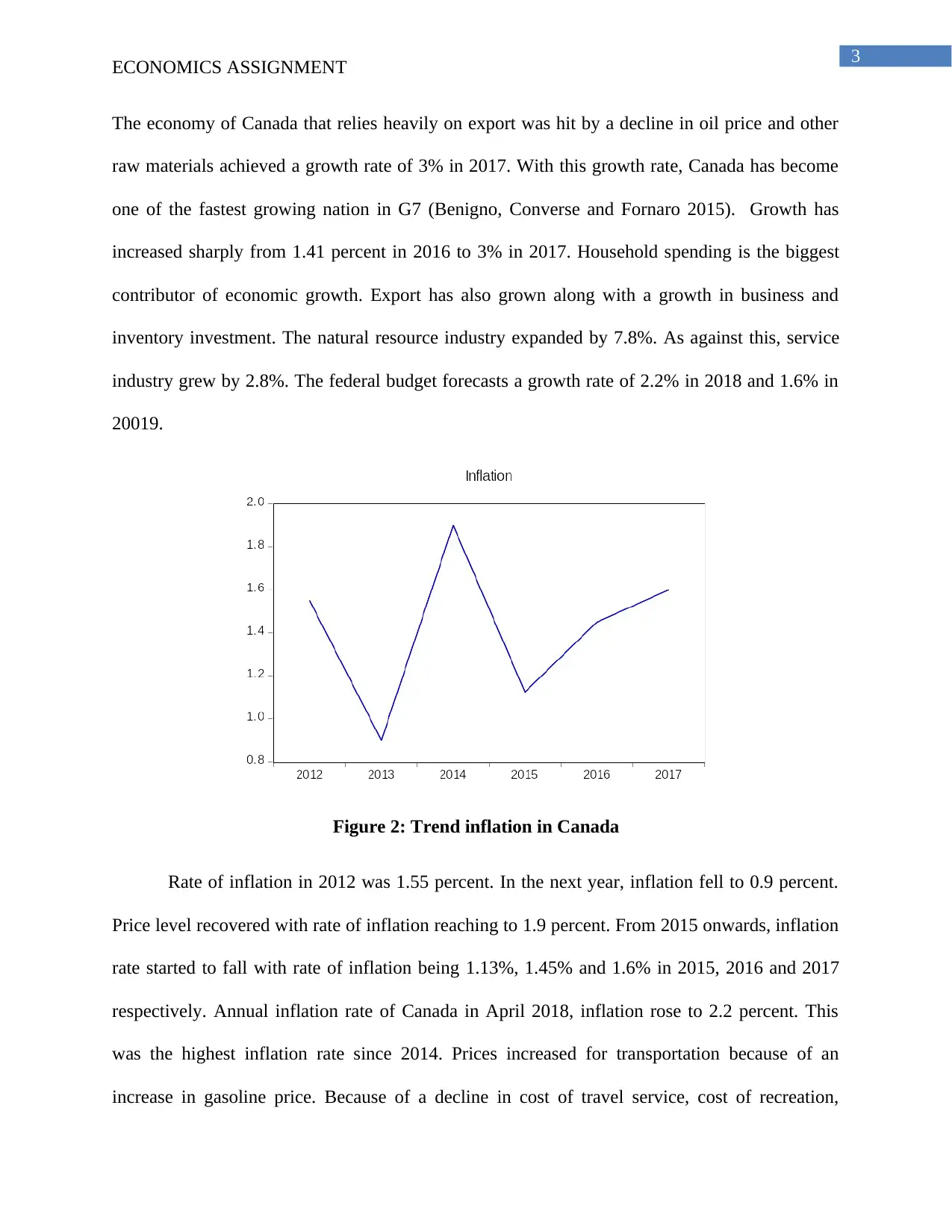
3
ECONOMICS ASSIGNMENT
The economy of Canada that relies heavily on export was hit by a decline in oil price and other
raw materials achieved a growth rate of 3% in 2017. With this growth rate, Canada has become
one of the fastest growing nation in G7 (Benigno, Converse and Fornaro 2015). Growth has
increased sharply from 1.41 percent in 2016 to 3% in 2017. Household spending is the biggest
contributor of economic growth. Export has also grown along with a growth in business and
inventory investment. The natural resource industry expanded by 7.8%. As against this, service
industry grew by 2.8%. The federal budget forecasts a growth rate of 2.2% in 2018 and 1.6% in
20019.
Figure 2: Trend inflation in Canada
Rate of inflation in 2012 was 1.55 percent. In the next year, inflation fell to 0.9 percent.
Price level recovered with rate of inflation reaching to 1.9 percent. From 2015 onwards, inflation
rate started to fall with rate of inflation being 1.13%, 1.45% and 1.6% in 2015, 2016 and 2017
respectively. Annual inflation rate of Canada in April 2018, inflation rose to 2.2 percent. This
was the highest inflation rate since 2014. Prices increased for transportation because of an
increase in gasoline price. Because of a decline in cost of travel service, cost of recreation,
ECONOMICS ASSIGNMENT
The economy of Canada that relies heavily on export was hit by a decline in oil price and other
raw materials achieved a growth rate of 3% in 2017. With this growth rate, Canada has become
one of the fastest growing nation in G7 (Benigno, Converse and Fornaro 2015). Growth has
increased sharply from 1.41 percent in 2016 to 3% in 2017. Household spending is the biggest
contributor of economic growth. Export has also grown along with a growth in business and
inventory investment. The natural resource industry expanded by 7.8%. As against this, service
industry grew by 2.8%. The federal budget forecasts a growth rate of 2.2% in 2018 and 1.6% in
20019.
Figure 2: Trend inflation in Canada
Rate of inflation in 2012 was 1.55 percent. In the next year, inflation fell to 0.9 percent.
Price level recovered with rate of inflation reaching to 1.9 percent. From 2015 onwards, inflation
rate started to fall with rate of inflation being 1.13%, 1.45% and 1.6% in 2015, 2016 and 2017
respectively. Annual inflation rate of Canada in April 2018, inflation rose to 2.2 percent. This
was the highest inflation rate since 2014. Prices increased for transportation because of an
increase in gasoline price. Because of a decline in cost of travel service, cost of recreation,
Secure Best Marks with AI Grader
Need help grading? Try our AI Grader for instant feedback on your assignments.
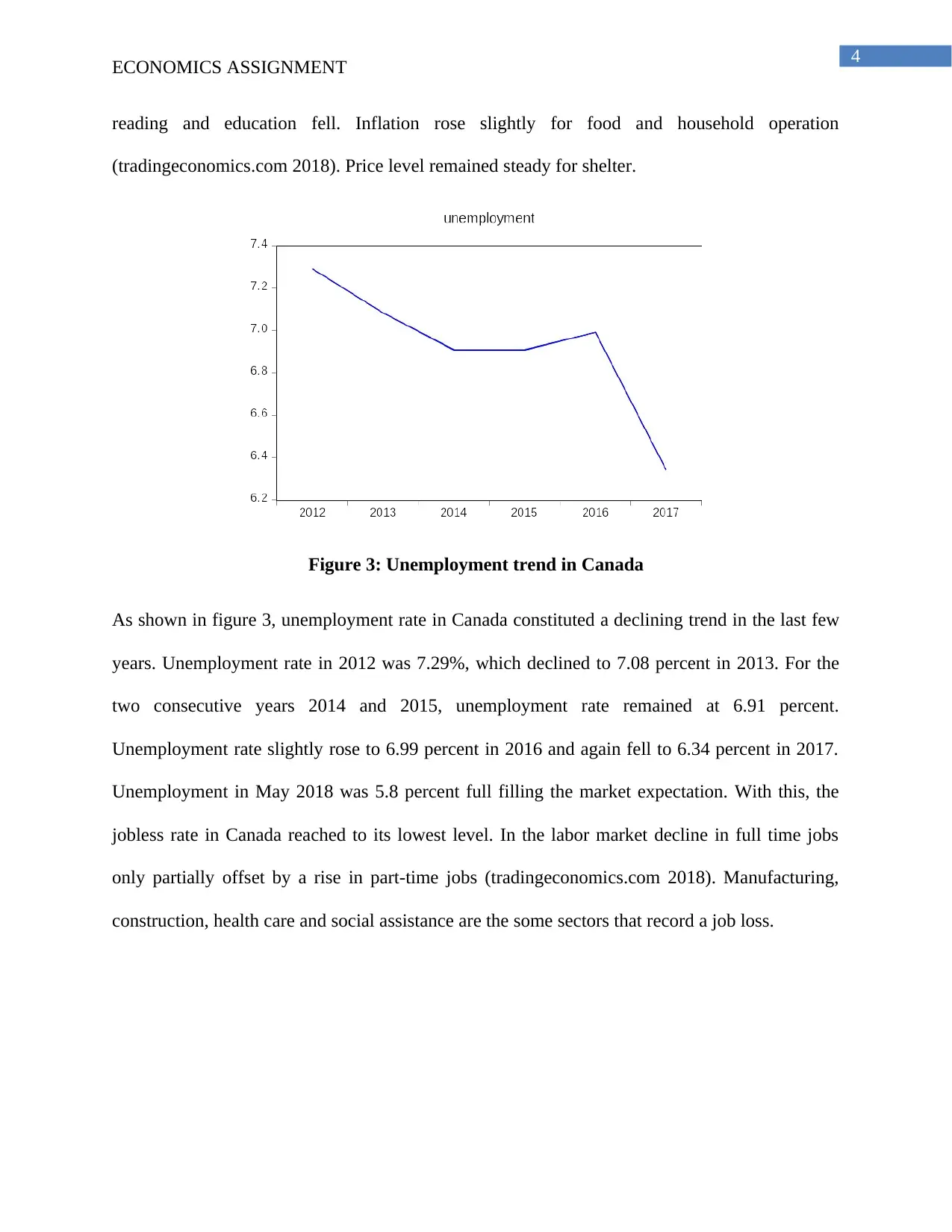
4
ECONOMICS ASSIGNMENT
reading and education fell. Inflation rose slightly for food and household operation
(tradingeconomics.com 2018). Price level remained steady for shelter.
Figure 3: Unemployment trend in Canada
As shown in figure 3, unemployment rate in Canada constituted a declining trend in the last few
years. Unemployment rate in 2012 was 7.29%, which declined to 7.08 percent in 2013. For the
two consecutive years 2014 and 2015, unemployment rate remained at 6.91 percent.
Unemployment rate slightly rose to 6.99 percent in 2016 and again fell to 6.34 percent in 2017.
Unemployment in May 2018 was 5.8 percent full filling the market expectation. With this, the
jobless rate in Canada reached to its lowest level. In the labor market decline in full time jobs
only partially offset by a rise in part-time jobs (tradingeconomics.com 2018). Manufacturing,
construction, health care and social assistance are the some sectors that record a job loss.
ECONOMICS ASSIGNMENT
reading and education fell. Inflation rose slightly for food and household operation
(tradingeconomics.com 2018). Price level remained steady for shelter.
Figure 3: Unemployment trend in Canada
As shown in figure 3, unemployment rate in Canada constituted a declining trend in the last few
years. Unemployment rate in 2012 was 7.29%, which declined to 7.08 percent in 2013. For the
two consecutive years 2014 and 2015, unemployment rate remained at 6.91 percent.
Unemployment rate slightly rose to 6.99 percent in 2016 and again fell to 6.34 percent in 2017.
Unemployment in May 2018 was 5.8 percent full filling the market expectation. With this, the
jobless rate in Canada reached to its lowest level. In the labor market decline in full time jobs
only partially offset by a rise in part-time jobs (tradingeconomics.com 2018). Manufacturing,
construction, health care and social assistance are the some sectors that record a job loss.

5
ECONOMICS ASSIGNMENT
Figure 4: Total debt in Canada
Total debt in Canada shows an overtime-increasing trend. Total debt in Canada during 2012 was
1191. 37 US dollar. Debt rose to 1254.08 in 2013. Total debt continued to increase with debt
reaching to 1481.65 US dollar in 2017.
Figure 5: Trend in interest rate of Canada
ECONOMICS ASSIGNMENT
Figure 4: Total debt in Canada
Total debt in Canada shows an overtime-increasing trend. Total debt in Canada during 2012 was
1191. 37 US dollar. Debt rose to 1254.08 in 2013. Total debt continued to increase with debt
reaching to 1481.65 US dollar in 2017.
Figure 5: Trend in interest rate of Canada
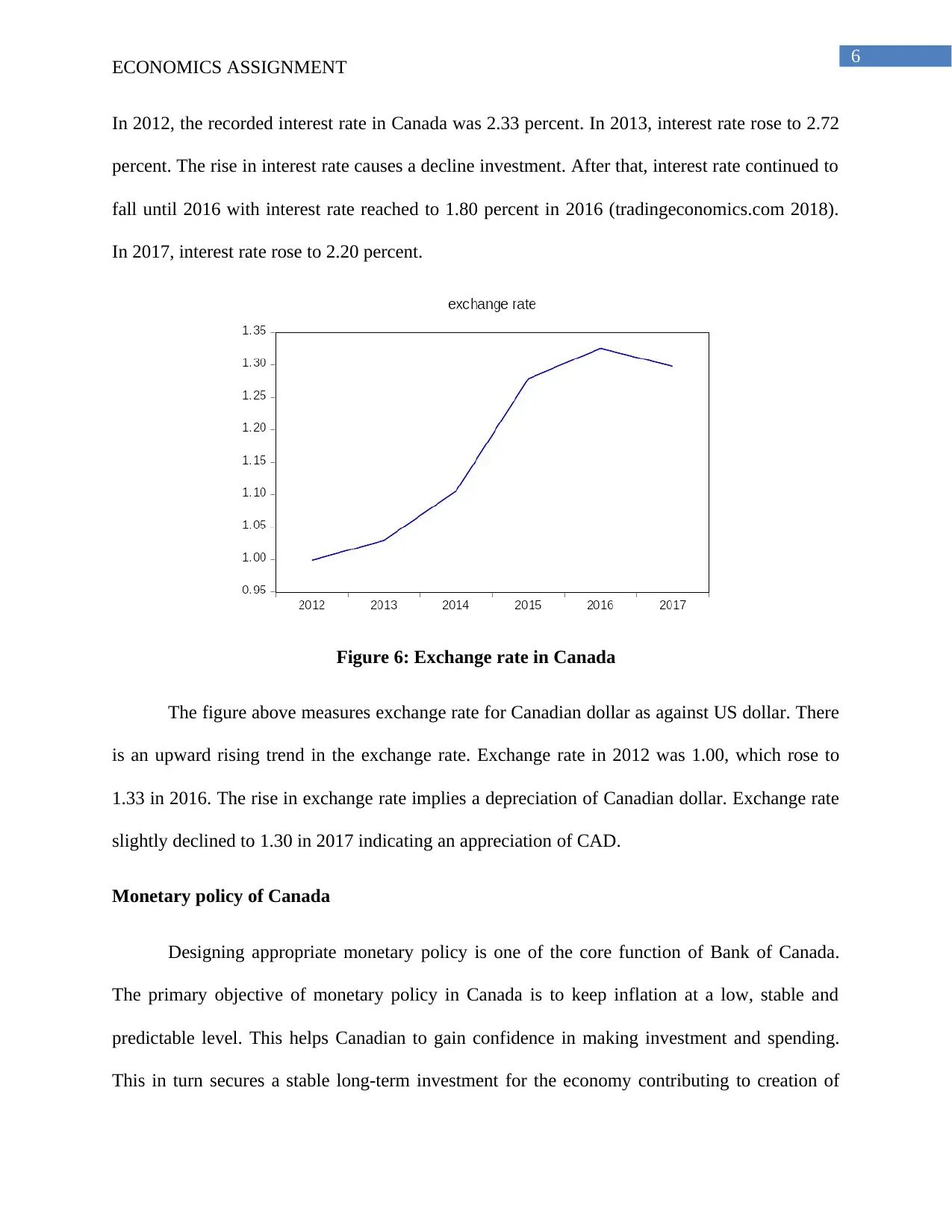
6
ECONOMICS ASSIGNMENT
In 2012, the recorded interest rate in Canada was 2.33 percent. In 2013, interest rate rose to 2.72
percent. The rise in interest rate causes a decline investment. After that, interest rate continued to
fall until 2016 with interest rate reached to 1.80 percent in 2016 (tradingeconomics.com 2018).
In 2017, interest rate rose to 2.20 percent.
Figure 6: Exchange rate in Canada
The figure above measures exchange rate for Canadian dollar as against US dollar. There
is an upward rising trend in the exchange rate. Exchange rate in 2012 was 1.00, which rose to
1.33 in 2016. The rise in exchange rate implies a depreciation of Canadian dollar. Exchange rate
slightly declined to 1.30 in 2017 indicating an appreciation of CAD.
Monetary policy of Canada
Designing appropriate monetary policy is one of the core function of Bank of Canada.
The primary objective of monetary policy in Canada is to keep inflation at a low, stable and
predictable level. This helps Canadian to gain confidence in making investment and spending.
This in turn secures a stable long-term investment for the economy contributing to creation of
ECONOMICS ASSIGNMENT
In 2012, the recorded interest rate in Canada was 2.33 percent. In 2013, interest rate rose to 2.72
percent. The rise in interest rate causes a decline investment. After that, interest rate continued to
fall until 2016 with interest rate reached to 1.80 percent in 2016 (tradingeconomics.com 2018).
In 2017, interest rate rose to 2.20 percent.
Figure 6: Exchange rate in Canada
The figure above measures exchange rate for Canadian dollar as against US dollar. There
is an upward rising trend in the exchange rate. Exchange rate in 2012 was 1.00, which rose to
1.33 in 2016. The rise in exchange rate implies a depreciation of Canadian dollar. Exchange rate
slightly declined to 1.30 in 2017 indicating an appreciation of CAD.
Monetary policy of Canada
Designing appropriate monetary policy is one of the core function of Bank of Canada.
The primary objective of monetary policy in Canada is to keep inflation at a low, stable and
predictable level. This helps Canadian to gain confidence in making investment and spending.
This in turn secures a stable long-term investment for the economy contributing to creation of
Paraphrase This Document
Need a fresh take? Get an instant paraphrase of this document with our AI Paraphraser
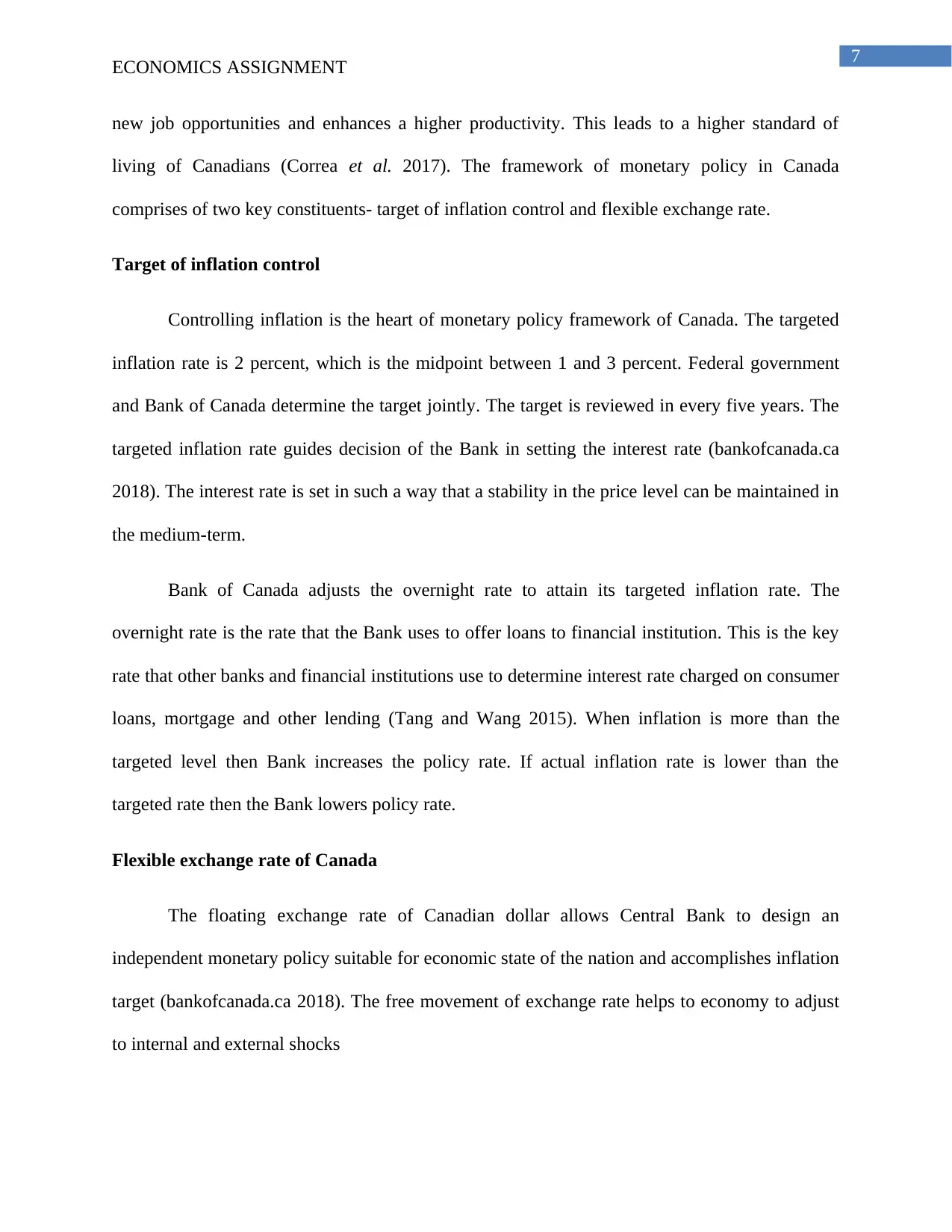
7
ECONOMICS ASSIGNMENT
new job opportunities and enhances a higher productivity. This leads to a higher standard of
living of Canadians (Correa et al. 2017). The framework of monetary policy in Canada
comprises of two key constituents- target of inflation control and flexible exchange rate.
Target of inflation control
Controlling inflation is the heart of monetary policy framework of Canada. The targeted
inflation rate is 2 percent, which is the midpoint between 1 and 3 percent. Federal government
and Bank of Canada determine the target jointly. The target is reviewed in every five years. The
targeted inflation rate guides decision of the Bank in setting the interest rate (bankofcanada.ca
2018). The interest rate is set in such a way that a stability in the price level can be maintained in
the medium-term.
Bank of Canada adjusts the overnight rate to attain its targeted inflation rate. The
overnight rate is the rate that the Bank uses to offer loans to financial institution. This is the key
rate that other banks and financial institutions use to determine interest rate charged on consumer
loans, mortgage and other lending (Tang and Wang 2015). When inflation is more than the
targeted level then Bank increases the policy rate. If actual inflation rate is lower than the
targeted rate then the Bank lowers policy rate.
Flexible exchange rate of Canada
The floating exchange rate of Canadian dollar allows Central Bank to design an
independent monetary policy suitable for economic state of the nation and accomplishes inflation
target (bankofcanada.ca 2018). The free movement of exchange rate helps to economy to adjust
to internal and external shocks
ECONOMICS ASSIGNMENT
new job opportunities and enhances a higher productivity. This leads to a higher standard of
living of Canadians (Correa et al. 2017). The framework of monetary policy in Canada
comprises of two key constituents- target of inflation control and flexible exchange rate.
Target of inflation control
Controlling inflation is the heart of monetary policy framework of Canada. The targeted
inflation rate is 2 percent, which is the midpoint between 1 and 3 percent. Federal government
and Bank of Canada determine the target jointly. The target is reviewed in every five years. The
targeted inflation rate guides decision of the Bank in setting the interest rate (bankofcanada.ca
2018). The interest rate is set in such a way that a stability in the price level can be maintained in
the medium-term.
Bank of Canada adjusts the overnight rate to attain its targeted inflation rate. The
overnight rate is the rate that the Bank uses to offer loans to financial institution. This is the key
rate that other banks and financial institutions use to determine interest rate charged on consumer
loans, mortgage and other lending (Tang and Wang 2015). When inflation is more than the
targeted level then Bank increases the policy rate. If actual inflation rate is lower than the
targeted rate then the Bank lowers policy rate.
Flexible exchange rate of Canada
The floating exchange rate of Canadian dollar allows Central Bank to design an
independent monetary policy suitable for economic state of the nation and accomplishes inflation
target (bankofcanada.ca 2018). The free movement of exchange rate helps to economy to adjust
to internal and external shocks
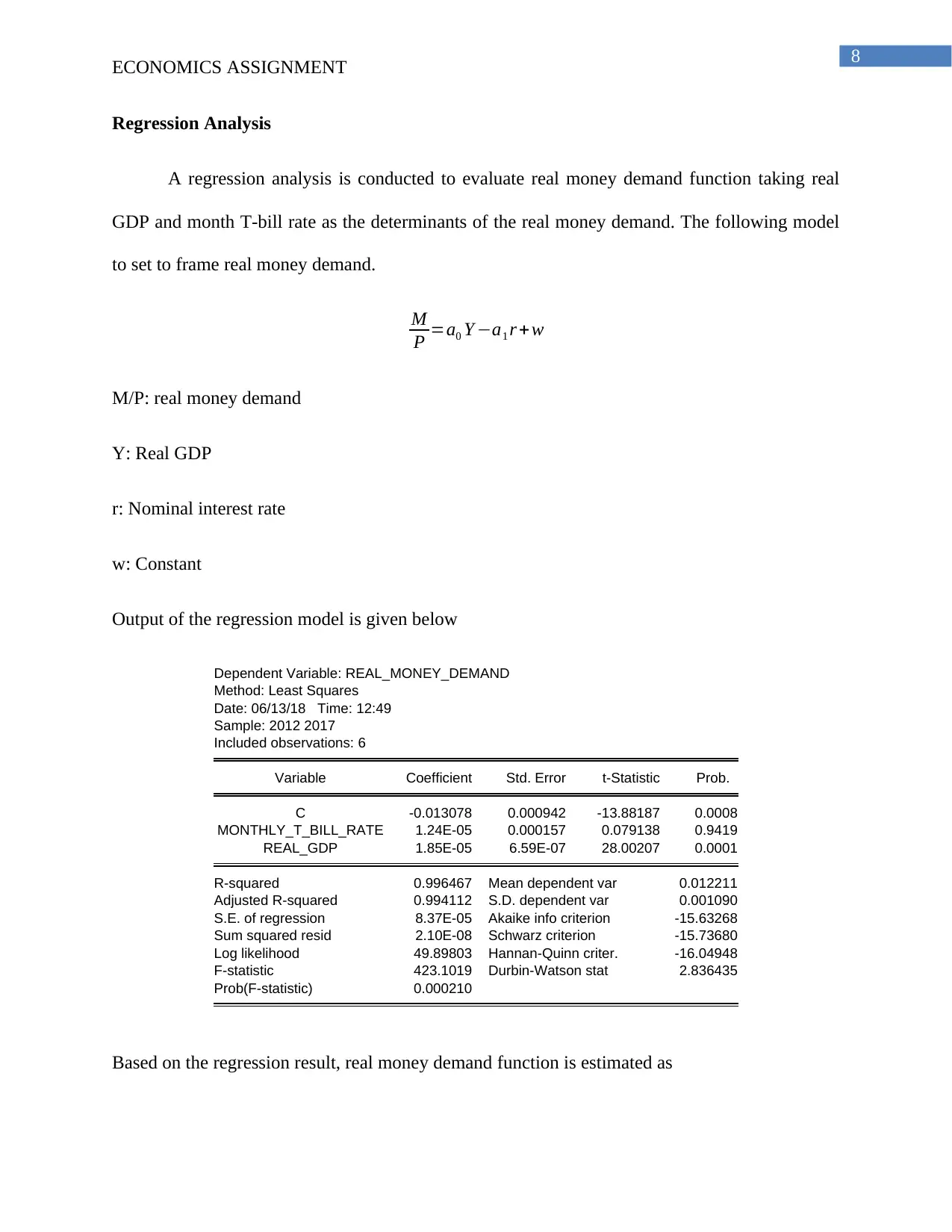
8
ECONOMICS ASSIGNMENT
Regression Analysis
A regression analysis is conducted to evaluate real money demand function taking real
GDP and month T-bill rate as the determinants of the real money demand. The following model
to set to frame real money demand.
M
P =a0 Y −a1 r +w
M/P: real money demand
Y: Real GDP
r: Nominal interest rate
w: Constant
Output of the regression model is given below
Dependent Variable: REAL_MONEY_DEMAND
Method: Least Squares
Date: 06/13/18 Time: 12:49
Sample: 2012 2017
Included observations: 6
Variable Coefficient Std. Error t-Statistic Prob.
C -0.013078 0.000942 -13.88187 0.0008
MONTHLY_T_BILL_RATE 1.24E-05 0.000157 0.079138 0.9419
REAL_GDP 1.85E-05 6.59E-07 28.00207 0.0001
R-squared 0.996467 Mean dependent var 0.012211
Adjusted R-squared 0.994112 S.D. dependent var 0.001090
S.E. of regression 8.37E-05 Akaike info criterion -15.63268
Sum squared resid 2.10E-08 Schwarz criterion -15.73680
Log likelihood 49.89803 Hannan-Quinn criter. -16.04948
F-statistic 423.1019 Durbin-Watson stat 2.836435
Prob(F-statistic) 0.000210
Based on the regression result, real money demand function is estimated as
ECONOMICS ASSIGNMENT
Regression Analysis
A regression analysis is conducted to evaluate real money demand function taking real
GDP and month T-bill rate as the determinants of the real money demand. The following model
to set to frame real money demand.
M
P =a0 Y −a1 r +w
M/P: real money demand
Y: Real GDP
r: Nominal interest rate
w: Constant
Output of the regression model is given below
Dependent Variable: REAL_MONEY_DEMAND
Method: Least Squares
Date: 06/13/18 Time: 12:49
Sample: 2012 2017
Included observations: 6
Variable Coefficient Std. Error t-Statistic Prob.
C -0.013078 0.000942 -13.88187 0.0008
MONTHLY_T_BILL_RATE 1.24E-05 0.000157 0.079138 0.9419
REAL_GDP 1.85E-05 6.59E-07 28.00207 0.0001
R-squared 0.996467 Mean dependent var 0.012211
Adjusted R-squared 0.994112 S.D. dependent var 0.001090
S.E. of regression 8.37E-05 Akaike info criterion -15.63268
Sum squared resid 2.10E-08 Schwarz criterion -15.73680
Log likelihood 49.89803 Hannan-Quinn criter. -16.04948
F-statistic 423.1019 Durbin-Watson stat 2.836435
Prob(F-statistic) 0.000210
Based on the regression result, real money demand function is estimated as
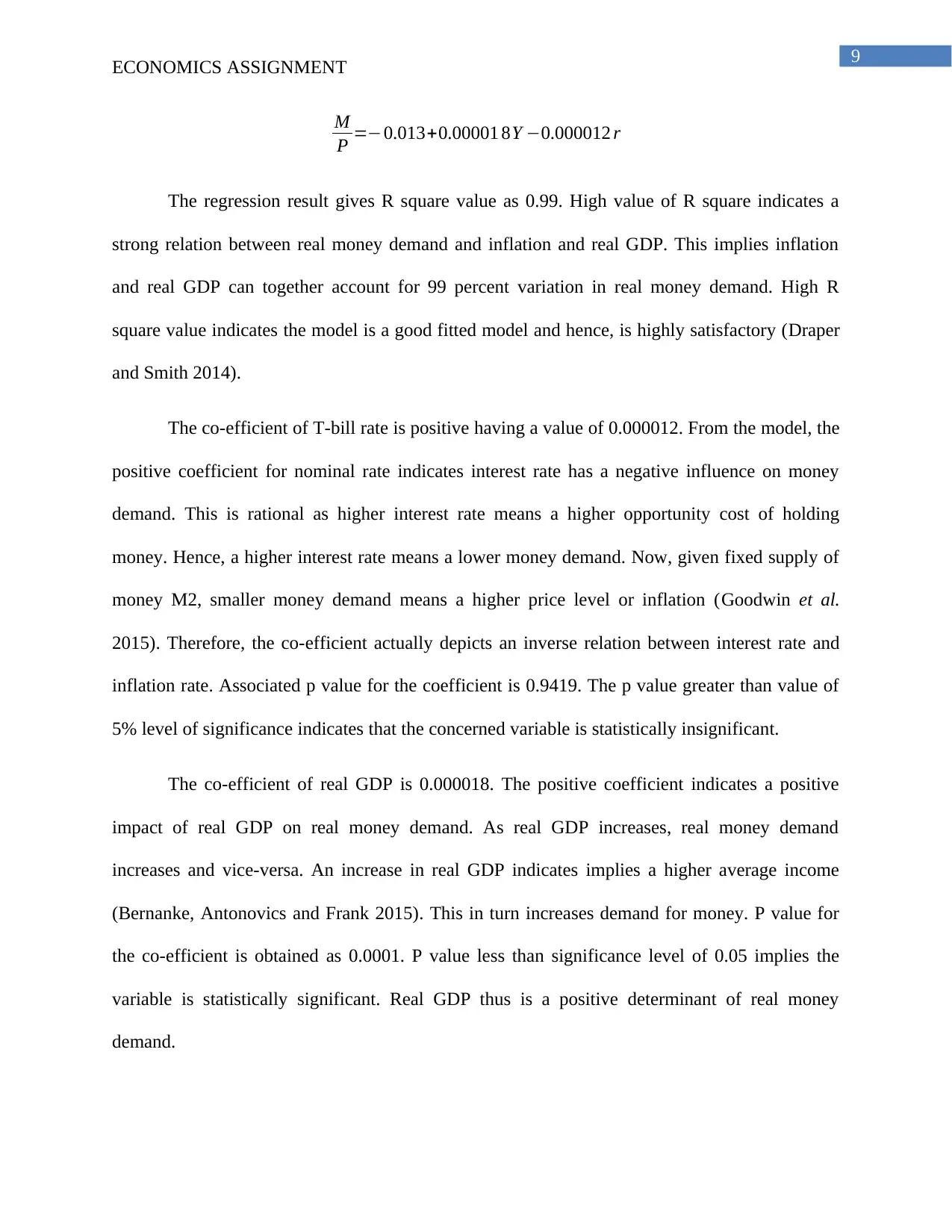
9
ECONOMICS ASSIGNMENT
M
P =−0.013+0.00001 8Y −0.000012 r
The regression result gives R square value as 0.99. High value of R square indicates a
strong relation between real money demand and inflation and real GDP. This implies inflation
and real GDP can together account for 99 percent variation in real money demand. High R
square value indicates the model is a good fitted model and hence, is highly satisfactory (Draper
and Smith 2014).
The co-efficient of T-bill rate is positive having a value of 0.000012. From the model, the
positive coefficient for nominal rate indicates interest rate has a negative influence on money
demand. This is rational as higher interest rate means a higher opportunity cost of holding
money. Hence, a higher interest rate means a lower money demand. Now, given fixed supply of
money M2, smaller money demand means a higher price level or inflation (Goodwin et al.
2015). Therefore, the co-efficient actually depicts an inverse relation between interest rate and
inflation rate. Associated p value for the coefficient is 0.9419. The p value greater than value of
5% level of significance indicates that the concerned variable is statistically insignificant.
The co-efficient of real GDP is 0.000018. The positive coefficient indicates a positive
impact of real GDP on real money demand. As real GDP increases, real money demand
increases and vice-versa. An increase in real GDP indicates implies a higher average income
(Bernanke, Antonovics and Frank 2015). This in turn increases demand for money. P value for
the co-efficient is obtained as 0.0001. P value less than significance level of 0.05 implies the
variable is statistically significant. Real GDP thus is a positive determinant of real money
demand.
ECONOMICS ASSIGNMENT
M
P =−0.013+0.00001 8Y −0.000012 r
The regression result gives R square value as 0.99. High value of R square indicates a
strong relation between real money demand and inflation and real GDP. This implies inflation
and real GDP can together account for 99 percent variation in real money demand. High R
square value indicates the model is a good fitted model and hence, is highly satisfactory (Draper
and Smith 2014).
The co-efficient of T-bill rate is positive having a value of 0.000012. From the model, the
positive coefficient for nominal rate indicates interest rate has a negative influence on money
demand. This is rational as higher interest rate means a higher opportunity cost of holding
money. Hence, a higher interest rate means a lower money demand. Now, given fixed supply of
money M2, smaller money demand means a higher price level or inflation (Goodwin et al.
2015). Therefore, the co-efficient actually depicts an inverse relation between interest rate and
inflation rate. Associated p value for the coefficient is 0.9419. The p value greater than value of
5% level of significance indicates that the concerned variable is statistically insignificant.
The co-efficient of real GDP is 0.000018. The positive coefficient indicates a positive
impact of real GDP on real money demand. As real GDP increases, real money demand
increases and vice-versa. An increase in real GDP indicates implies a higher average income
(Bernanke, Antonovics and Frank 2015). This in turn increases demand for money. P value for
the co-efficient is obtained as 0.0001. P value less than significance level of 0.05 implies the
variable is statistically significant. Real GDP thus is a positive determinant of real money
demand.
Secure Best Marks with AI Grader
Need help grading? Try our AI Grader for instant feedback on your assignments.
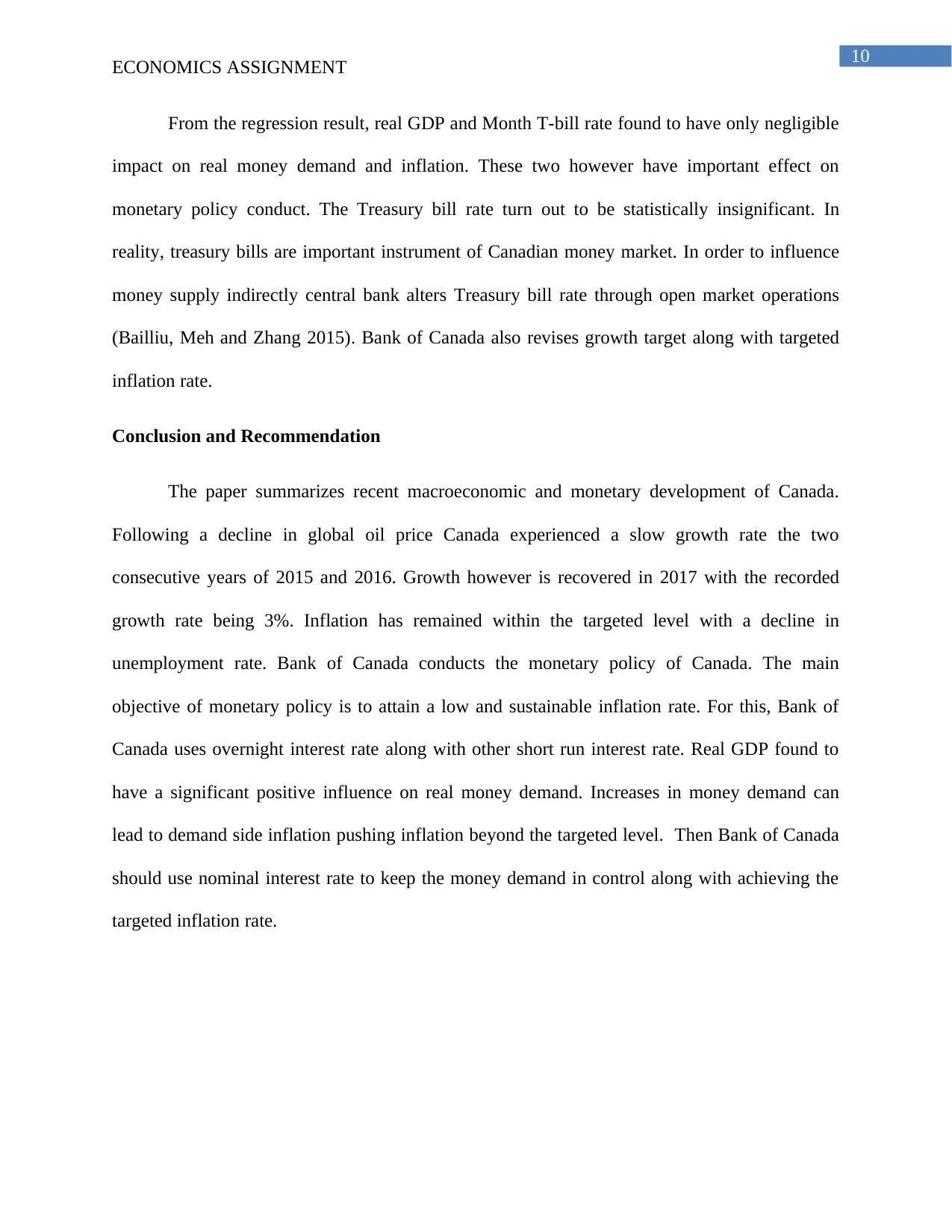
10
ECONOMICS ASSIGNMENT
From the regression result, real GDP and Month T-bill rate found to have only negligible
impact on real money demand and inflation. These two however have important effect on
monetary policy conduct. The Treasury bill rate turn out to be statistically insignificant. In
reality, treasury bills are important instrument of Canadian money market. In order to influence
money supply indirectly central bank alters Treasury bill rate through open market operations
(Bailliu, Meh and Zhang 2015). Bank of Canada also revises growth target along with targeted
inflation rate.
Conclusion and Recommendation
The paper summarizes recent macroeconomic and monetary development of Canada.
Following a decline in global oil price Canada experienced a slow growth rate the two
consecutive years of 2015 and 2016. Growth however is recovered in 2017 with the recorded
growth rate being 3%. Inflation has remained within the targeted level with a decline in
unemployment rate. Bank of Canada conducts the monetary policy of Canada. The main
objective of monetary policy is to attain a low and sustainable inflation rate. For this, Bank of
Canada uses overnight interest rate along with other short run interest rate. Real GDP found to
have a significant positive influence on real money demand. Increases in money demand can
lead to demand side inflation pushing inflation beyond the targeted level. Then Bank of Canada
should use nominal interest rate to keep the money demand in control along with achieving the
targeted inflation rate.
ECONOMICS ASSIGNMENT
From the regression result, real GDP and Month T-bill rate found to have only negligible
impact on real money demand and inflation. These two however have important effect on
monetary policy conduct. The Treasury bill rate turn out to be statistically insignificant. In
reality, treasury bills are important instrument of Canadian money market. In order to influence
money supply indirectly central bank alters Treasury bill rate through open market operations
(Bailliu, Meh and Zhang 2015). Bank of Canada also revises growth target along with targeted
inflation rate.
Conclusion and Recommendation
The paper summarizes recent macroeconomic and monetary development of Canada.
Following a decline in global oil price Canada experienced a slow growth rate the two
consecutive years of 2015 and 2016. Growth however is recovered in 2017 with the recorded
growth rate being 3%. Inflation has remained within the targeted level with a decline in
unemployment rate. Bank of Canada conducts the monetary policy of Canada. The main
objective of monetary policy is to attain a low and sustainable inflation rate. For this, Bank of
Canada uses overnight interest rate along with other short run interest rate. Real GDP found to
have a significant positive influence on real money demand. Increases in money demand can
lead to demand side inflation pushing inflation beyond the targeted level. Then Bank of Canada
should use nominal interest rate to keep the money demand in control along with achieving the
targeted inflation rate.
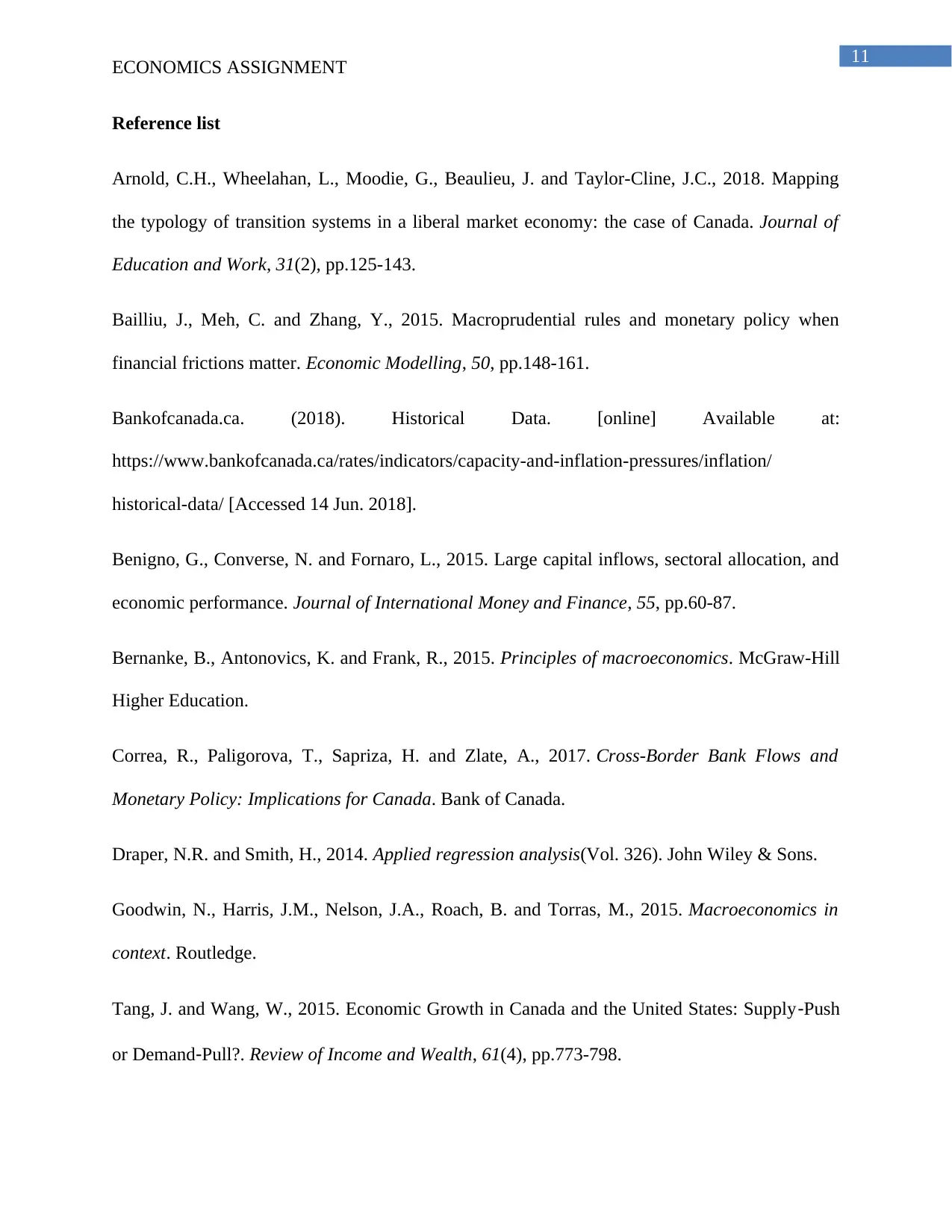
11
ECONOMICS ASSIGNMENT
Reference list
Arnold, C.H., Wheelahan, L., Moodie, G., Beaulieu, J. and Taylor-Cline, J.C., 2018. Mapping
the typology of transition systems in a liberal market economy: the case of Canada. Journal of
Education and Work, 31(2), pp.125-143.
Bailliu, J., Meh, C. and Zhang, Y., 2015. Macroprudential rules and monetary policy when
financial frictions matter. Economic Modelling, 50, pp.148-161.
Bankofcanada.ca. (2018). Historical Data. [online] Available at:
https://www.bankofcanada.ca/rates/indicators/capacity-and-inflation-pressures/inflation/
historical-data/ [Accessed 14 Jun. 2018].
Benigno, G., Converse, N. and Fornaro, L., 2015. Large capital inflows, sectoral allocation, and
economic performance. Journal of International Money and Finance, 55, pp.60-87.
Bernanke, B., Antonovics, K. and Frank, R., 2015. Principles of macroeconomics. McGraw-Hill
Higher Education.
Correa, R., Paligorova, T., Sapriza, H. and Zlate, A., 2017. Cross-Border Bank Flows and
Monetary Policy: Implications for Canada. Bank of Canada.
Draper, N.R. and Smith, H., 2014. Applied regression analysis(Vol. 326). John Wiley & Sons.
Goodwin, N., Harris, J.M., Nelson, J.A., Roach, B. and Torras, M., 2015. Macroeconomics in
context. Routledge.
Tang, J. and Wang, W., 2015. Economic Growth in Canada and the United States: Supply‐Push
or Demand‐Pull?. Review of Income and Wealth, 61(4), pp.773-798.
ECONOMICS ASSIGNMENT
Reference list
Arnold, C.H., Wheelahan, L., Moodie, G., Beaulieu, J. and Taylor-Cline, J.C., 2018. Mapping
the typology of transition systems in a liberal market economy: the case of Canada. Journal of
Education and Work, 31(2), pp.125-143.
Bailliu, J., Meh, C. and Zhang, Y., 2015. Macroprudential rules and monetary policy when
financial frictions matter. Economic Modelling, 50, pp.148-161.
Bankofcanada.ca. (2018). Historical Data. [online] Available at:
https://www.bankofcanada.ca/rates/indicators/capacity-and-inflation-pressures/inflation/
historical-data/ [Accessed 14 Jun. 2018].
Benigno, G., Converse, N. and Fornaro, L., 2015. Large capital inflows, sectoral allocation, and
economic performance. Journal of International Money and Finance, 55, pp.60-87.
Bernanke, B., Antonovics, K. and Frank, R., 2015. Principles of macroeconomics. McGraw-Hill
Higher Education.
Correa, R., Paligorova, T., Sapriza, H. and Zlate, A., 2017. Cross-Border Bank Flows and
Monetary Policy: Implications for Canada. Bank of Canada.
Draper, N.R. and Smith, H., 2014. Applied regression analysis(Vol. 326). John Wiley & Sons.
Goodwin, N., Harris, J.M., Nelson, J.A., Roach, B. and Torras, M., 2015. Macroeconomics in
context. Routledge.
Tang, J. and Wang, W., 2015. Economic Growth in Canada and the United States: Supply‐Push
or Demand‐Pull?. Review of Income and Wealth, 61(4), pp.773-798.
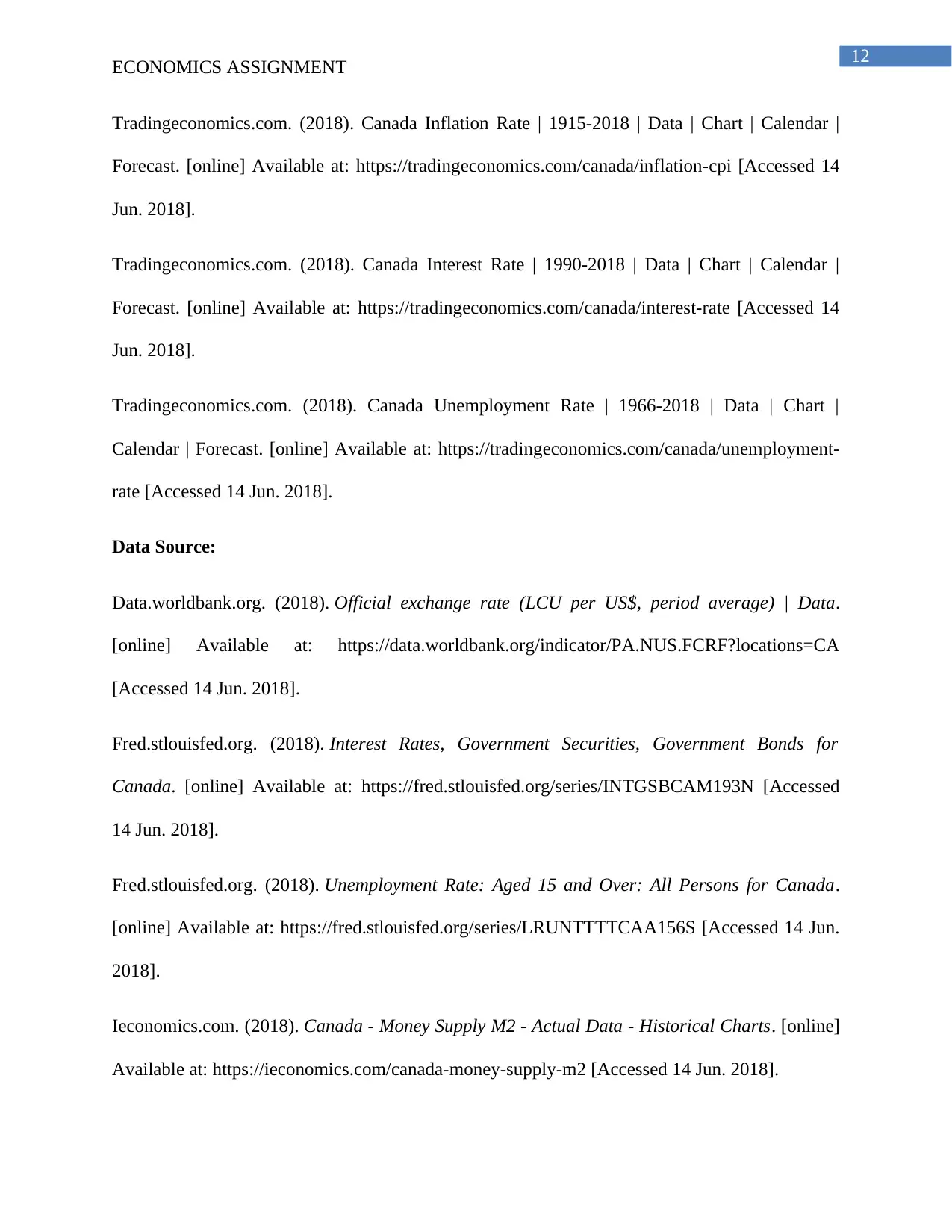
12
ECONOMICS ASSIGNMENT
Tradingeconomics.com. (2018). Canada Inflation Rate | 1915-2018 | Data | Chart | Calendar |
Forecast. [online] Available at: https://tradingeconomics.com/canada/inflation-cpi [Accessed 14
Jun. 2018].
Tradingeconomics.com. (2018). Canada Interest Rate | 1990-2018 | Data | Chart | Calendar |
Forecast. [online] Available at: https://tradingeconomics.com/canada/interest-rate [Accessed 14
Jun. 2018].
Tradingeconomics.com. (2018). Canada Unemployment Rate | 1966-2018 | Data | Chart |
Calendar | Forecast. [online] Available at: https://tradingeconomics.com/canada/unemployment-
rate [Accessed 14 Jun. 2018].
Data Source:
Data.worldbank.org. (2018). Official exchange rate (LCU per US$, period average) | Data.
[online] Available at: https://data.worldbank.org/indicator/PA.NUS.FCRF?locations=CA
[Accessed 14 Jun. 2018].
Fred.stlouisfed.org. (2018). Interest Rates, Government Securities, Government Bonds for
Canada. [online] Available at: https://fred.stlouisfed.org/series/INTGSBCAM193N [Accessed
14 Jun. 2018].
Fred.stlouisfed.org. (2018). Unemployment Rate: Aged 15 and Over: All Persons for Canada.
[online] Available at: https://fred.stlouisfed.org/series/LRUNTTTTCAA156S [Accessed 14 Jun.
2018].
Ieconomics.com. (2018). Canada - Money Supply M2 - Actual Data - Historical Charts. [online]
Available at: https://ieconomics.com/canada-money-supply-m2 [Accessed 14 Jun. 2018].
ECONOMICS ASSIGNMENT
Tradingeconomics.com. (2018). Canada Inflation Rate | 1915-2018 | Data | Chart | Calendar |
Forecast. [online] Available at: https://tradingeconomics.com/canada/inflation-cpi [Accessed 14
Jun. 2018].
Tradingeconomics.com. (2018). Canada Interest Rate | 1990-2018 | Data | Chart | Calendar |
Forecast. [online] Available at: https://tradingeconomics.com/canada/interest-rate [Accessed 14
Jun. 2018].
Tradingeconomics.com. (2018). Canada Unemployment Rate | 1966-2018 | Data | Chart |
Calendar | Forecast. [online] Available at: https://tradingeconomics.com/canada/unemployment-
rate [Accessed 14 Jun. 2018].
Data Source:
Data.worldbank.org. (2018). Official exchange rate (LCU per US$, period average) | Data.
[online] Available at: https://data.worldbank.org/indicator/PA.NUS.FCRF?locations=CA
[Accessed 14 Jun. 2018].
Fred.stlouisfed.org. (2018). Interest Rates, Government Securities, Government Bonds for
Canada. [online] Available at: https://fred.stlouisfed.org/series/INTGSBCAM193N [Accessed
14 Jun. 2018].
Fred.stlouisfed.org. (2018). Unemployment Rate: Aged 15 and Over: All Persons for Canada.
[online] Available at: https://fred.stlouisfed.org/series/LRUNTTTTCAA156S [Accessed 14 Jun.
2018].
Ieconomics.com. (2018). Canada - Money Supply M2 - Actual Data - Historical Charts. [online]
Available at: https://ieconomics.com/canada-money-supply-m2 [Accessed 14 Jun. 2018].
Paraphrase This Document
Need a fresh take? Get an instant paraphrase of this document with our AI Paraphraser
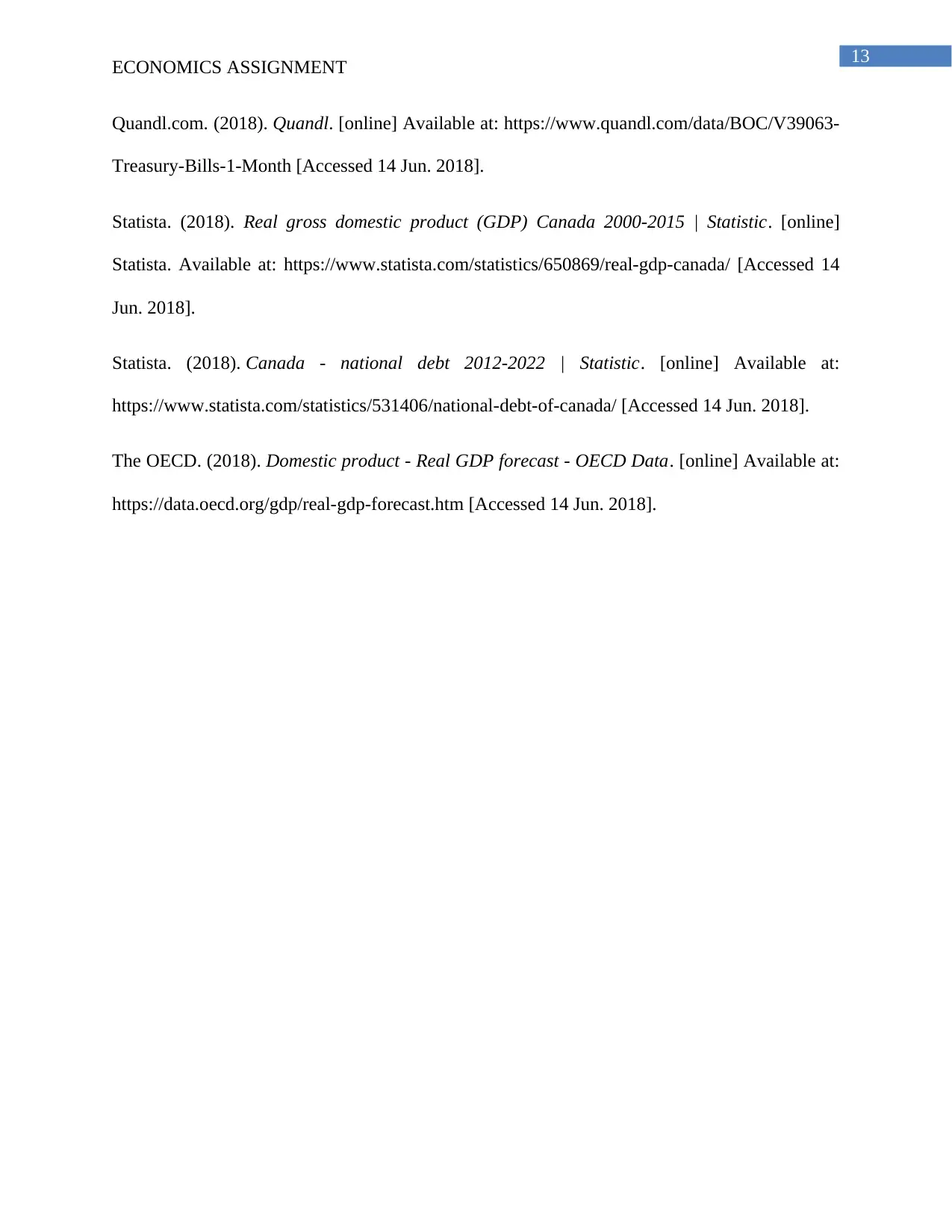
13
ECONOMICS ASSIGNMENT
Quandl.com. (2018). Quandl. [online] Available at: https://www.quandl.com/data/BOC/V39063-
Treasury-Bills-1-Month [Accessed 14 Jun. 2018].
Statista. (2018). Real gross domestic product (GDP) Canada 2000-2015 | Statistic. [online]
Statista. Available at: https://www.statista.com/statistics/650869/real-gdp-canada/ [Accessed 14
Jun. 2018].
Statista. (2018). Canada - national debt 2012-2022 | Statistic. [online] Available at:
https://www.statista.com/statistics/531406/national-debt-of-canada/ [Accessed 14 Jun. 2018].
The OECD. (2018). Domestic product - Real GDP forecast - OECD Data. [online] Available at:
https://data.oecd.org/gdp/real-gdp-forecast.htm [Accessed 14 Jun. 2018].
ECONOMICS ASSIGNMENT
Quandl.com. (2018). Quandl. [online] Available at: https://www.quandl.com/data/BOC/V39063-
Treasury-Bills-1-Month [Accessed 14 Jun. 2018].
Statista. (2018). Real gross domestic product (GDP) Canada 2000-2015 | Statistic. [online]
Statista. Available at: https://www.statista.com/statistics/650869/real-gdp-canada/ [Accessed 14
Jun. 2018].
Statista. (2018). Canada - national debt 2012-2022 | Statistic. [online] Available at:
https://www.statista.com/statistics/531406/national-debt-of-canada/ [Accessed 14 Jun. 2018].
The OECD. (2018). Domestic product - Real GDP forecast - OECD Data. [online] Available at:
https://data.oecd.org/gdp/real-gdp-forecast.htm [Accessed 14 Jun. 2018].
1 out of 14
Related Documents
Your All-in-One AI-Powered Toolkit for Academic Success.
+13062052269
info@desklib.com
Available 24*7 on WhatsApp / Email
![[object Object]](/_next/static/media/star-bottom.7253800d.svg)
Unlock your academic potential
© 2024 | Zucol Services PVT LTD | All rights reserved.





